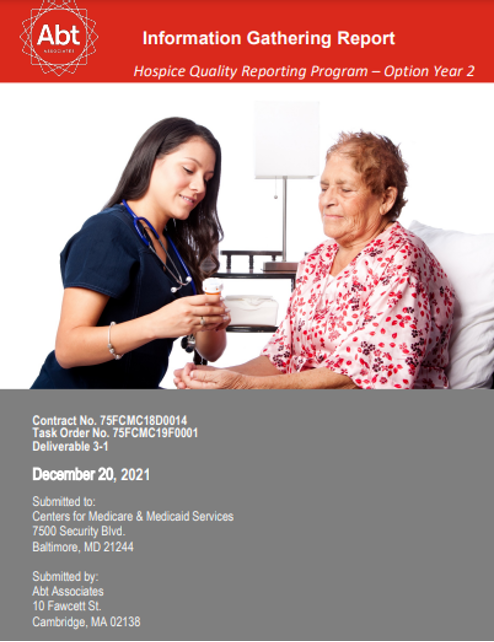Mary Madison, RN, RAC-CT, CDP
Clinical Consultant – Briggs Healthcare
CMS has released the Hospice Quality Reported Program 2021 Information Gathering Reporting. This report provides information from literature reviews and expert interviews that supports expansion of the hospice quality reporting program. Specific topics include treatment of moderate to severe pain, patient preferences, spiritual care, social needs, medication management, and other topics related to hospice quality.

This is a 140-page report. Please share the report with your team and colleagues.
Many Americans rely on hospice care for end-of-life support. In 2019, more than 1.6 million Americans received hospice care, with Centers for Medicare & Medicaid Services (CMS) spending $20.9 billion on hospice services (MedPAC, 2021). High quality hospice services are critical to terminally ill patients. CMS anticipates expanding the Hospice Quality Reporting Program (HQRP) over the next several years to include additional meaningful quality measures to help consumers make informed decisions when selecting a hospice for end-of-life-support. This expansion includes introducing the Hospice Outcomes & Patient Evaluation (HOPE), a patient assessment instrument that will incorporate the remaining Hospice Item Set (HIS) and developing outcome and other quality measures to assess the quality of care provided to hospice patients throughout the hospice stay.
The Hospice Information Gathering Reports support these efforts by reviewing available resources to inform HOPE development and related quality measures. Since CMS released the last Information Gathering Report, a second annual technical expert panel (TEP) meeting was held. The TEP deliberations, in addition to discussions with the HOPE development team, the hospice quality measurement development team, and federal stakeholders, identified areas where additional information could support the HQRP expansion.
This 2021 Information Gathering Report focuses on:
Treatment of moderate to severe pain. As in prior years, the TEP sought additional information to aid in developing a pain measure, including information on:
• The prevalence of moderate to severe pain,
• The length of time needed to see a reduction in moderate to severe pain,
• Whether patients experiencing pain that is difficult to control are equally distributed across hospice providers,
• Whether pain is over- or undertreated in the hospice setting.
To complement the detailed neuropathic pain discussion in last year’s report, here we provide information on:
• Current approaches to risk-adjusting for neuropathic pain,
• Potential disparities in neuropathic pain that may be exacerbated by risk-adjustment.
This information addresses TEP discussions on the appropriateness of a measure focused on higher levels of pain and the associated reassessment timeframe, whether such a measure would disproportionately impact certain hospices, and whether a pain reduction measure risks overtreatment of pain.
Patient Preferences. The TEP continued to stress the importance of integrating patient preferences in hospice care. For example, participating clinicians noted the importance of customized care planning which, ideally, should be informed by patient’s preferences for pain management and their individual preference for the acceptable threshold of pain. To support the development of valid and reliable spiritual and psychosocial care items, the instrument development team requested supporting evidence for assessment item(s) measuring patient preferences. To support these stakeholders, and better understand how patient preferences can be integrated into a quality measure we needed to learn:
• How patient preferences are used in quality measurement and improvement activities,
• Evidence for assessment item measurement of patient preferences for symptom management,
• Whether goal achievement is consistent with patient preferences,
• The concordance between patient/proxy report and medical/determinations that symptom management goals were achieved,
• The concordance between patient and proxy preferences for symptom management.
Spiritual and Psychosocial Assessment and Care: A primary goal for HOPE is to promote patient centered-care—in the hospice setting spiritual and psychosocial care are key components of patient centered care. To support the development of valid and reliable spiritual and psychosocial care items, the instrument development team requested scientific evidence and clinical guidelines related to spiritual assessment and care and psychosocial assessment and care, as conducted by spiritual care counselors and social workers, respectively. To support these stakeholders, we needed to learn:
• Standards of practice for assessment and interventions for spiritual and psychosocial care, including existing assessment items and tools,
• Evidence or guidelines for spiritual and psychosocial assessment and care as conducted by a spiritual counselor or social worker,
• Spiritual and psychosocial care outcomes for palliative care patients,
• Requirements for permission to use the Spiritual Distress Assessment Tool (SDAT).
Medication Management: The TEP supported a medication management measure. As such, preliminary information gathering activities will inform the quality measurement team as they consider further development of this concept. Specifically, we sought to understand the aspects of medication management that would be most relevant to quality of care in the hospice setting.
General Hospice Activities: To better inform HQRP measurement and reporting activities, we gathered information on recent quality measurement and reporting activities in the hospice setting.
